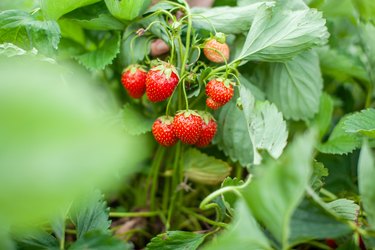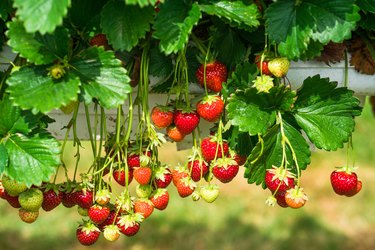
Strawberry leaves turning brown can be the result of attacks by a number of diseases and pests. Some of these are not harmful to the plant in the long term, but can reduce growth and production of fruit. Other causes of brown leaves on strawberry plants can be fatal if the plant is not otherwise healthy and thriving.
Plants Browning From Verticillium Wilt
Video of the Day
Verticillium wilt is caused by two closely related fungi, Verticillium albo-atrum and Verticilium dahliae. The fungus attacks strawberries as well as other garden plants like tomatoes and potatoes. Spores can remain in the soil for long periods, but strawberry plant roots must directly contact the contaminated soil to become infected.
Video of the Day
In new plants, symptoms are visible when runner growth begins in mid-July. In established plants you may not see signs of infection until the fruits begin to ripen. Older strawberry leaves brown around the edges and between the veins if infected with verticillium wilt. The stems may also turn red at the point where the leaves attach. You may also notice browning around the roots that indicates decay from the fungus.
Verticillium wilt can be prevented by not planting your strawberries in the same soil immediately after planting tomatoes, potatoes, eggplant or peppers, which are also vulnerable to the fungus. In soil that is already infected, you can fumigate the soil several months before planting.
Plants Browning From Leaf Scorch

Leaf scorch is spread by the spores of Diplocarpon earliana fungus. They are spread by rain splashing on the plants or by using contaminated gardening tools. Symptoms appear first as purple spots over the upper side of the leaves. These spots occur at any time during the growing season and as they grow, black fruiting bodies form at the center of each spot. This quickly becomes so widespread that the leaves wither, brown and dry up. The spores may also be seen on the stems and fruit stalks.
To prevent and control leaf scorch, clean away dead and fallen leaves, where the spores can spend the winter and reinfect plants in the spring. Applying fungicide to infected plants may also be effective in controlling the spread of spores to new plants.
Plants Browning From Leaf Spot
Leaf spot is caused by the fungus Mycosphaerella fragariae. The fungus attacks new leaves and stalks in the spring after spending the winter in old leaves on the ground. Leaf spot is more likely to occur in cool, wet weather. Symptoms include 1/8- to 1/4-inch spots that are light brown in the center and edged with a purple color. To control leaf spots on strawberry plants, a fungicide spray should be applied regularly.
Strawberry Leaves Turning Brown from Nematodes
Small round worms called nematodes can seriously damage strawberry plants if they grow to large enough numbers. Symptoms of an infestation of nematodes include brown or yellowed leaves, stunted growth and a general reduction in plant vigor. To determine if your strawberry plant has a nematode root disease, you can't rely on symptoms alone. Typically the plant will need to be dug out, and samples of the root and soil must be tested by a laboratory.

Eliminating nematodes from infected soil is difficult, but chemical treatment of the soil can be effective in controlling some types. Rotating crops with nematode-resistant plants is a natural option for control and prevention.